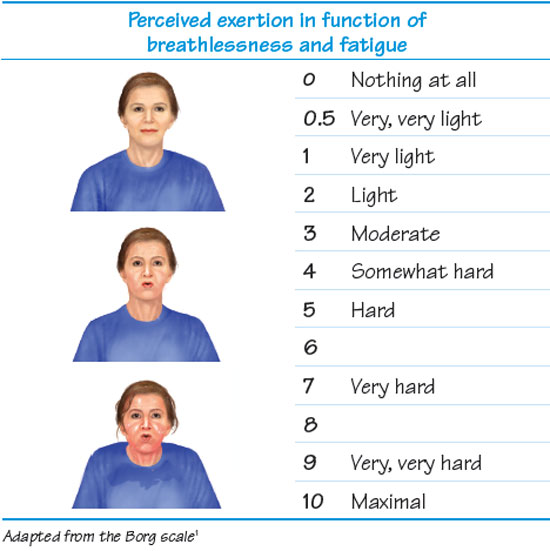
Step 3
Exercice program
Home exercise program
Excerpt from the Living well with COPD program, Integrating an exercise program into your life module.
Before beginning to do a home exercise program, the patient should be well-informed about where, when and how to do the exercises. They should also be capable of evaluating the severity of any shortness of breath or muscular pain they might experience, and of correctly recognizing their limits.
Recommendations to be made to the patient who does their exercises at home
- Put aside a period of the day that is suitable and amenable, and make exercising a priority.
- Wait for at least one hour after eating a meal.
- Choose a pleasant place and adapt the program depending upon the season of the year.
- Avoid any environmental factors that could aggravate a patient's symptoms (extreme heat, major cold spells, high rates of humidity, smog and harsh winds).
- If you like outdoor activities, plan an activity for each season (for example, cross-country skiing in the winter, gardening in the spring, bicycling in the summer and hiking in the fall).
- Also consider activities that you can do indoors (physical fitness centres, stationary bicycles, swimming); they have the obvious advantage of not being compromised by the weather outside.
- Find out all you can about exercise programs offered in your municipality. Base your choice upon what you like, the cost, transportation and what kind of value you expect to gain.
- Find out from your neighbours and friends what kind of exercises they do and ask them if you could join them.
- Choose a form of exercise that you like.
- Take your medication regularly, as prescribed. In some cases, taking your emergency medication (bronchodilator) before your workout may be more effective in helping relieve your shortness of breath.
- Wear comfortable clothes and good shoes, adapted to the temperature of the room where you exercise and that allows you to move about easily.
- Use your breathing techniques. By using the pursed lip breathing technique during your workout, you will be less out of breath.
How can you tell if the intensity of your workout is adequate?
The Perceived Exertion Scale should be used by patients to evaluate the severity of their shortness of breath and muscle fatigue.

The scale is graduated from 0 to 10. It is recommended that the patient do their exercises at a shortness of breath and fatigue level of somewhere between 4 and 6 out of 10. For example, at this level, the patient should be capable of answering someone who asks them a question, but not be able to carry on a conversation.
IMPORTANT
Prevent the patient from going over level 6 on the Perceived Exertion Scale. If they go over 6, the intensity of their workout is too high.
Recognize one's limits
Normal signs that can appear when one is doing exercise:
- Light to moderate shortness of breath
- Sweating
- Fatigue or heat in a person's legs
- Minor muscle or joint pain
*If the patient feels none of these symptoms, it is possible that the intensity of their workout is insufficient.
Abnormal signs:
- Chest pain
- Severe joint pain
- Dizziness or vertigo
- Palpitations
- Significant and extended respiratory difficulties
- Headaches
*If the patient experiences one or several of these symptoms, they must temporarily stop doing the exercise and contact their physician and/or health care professional.

